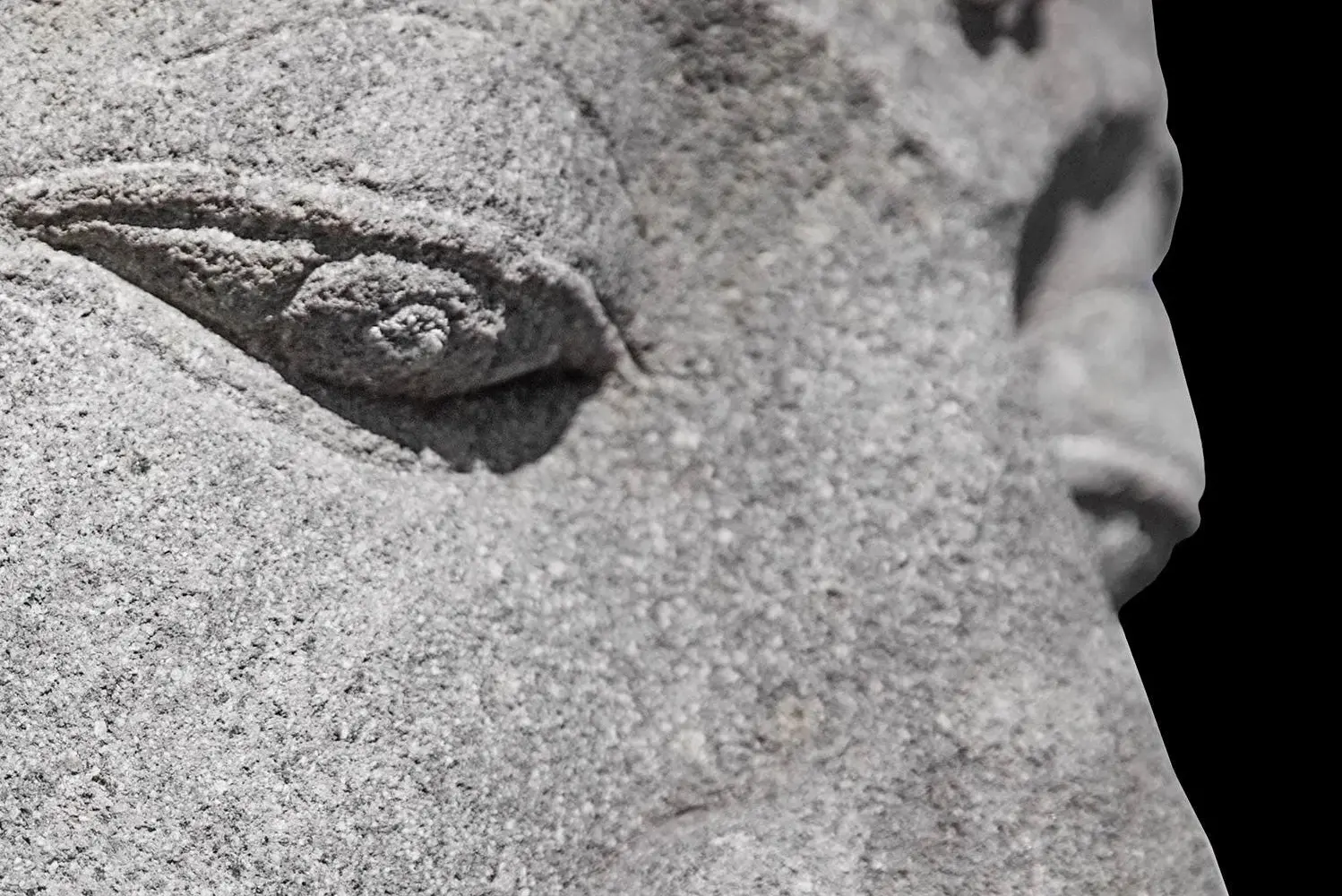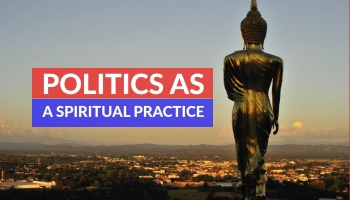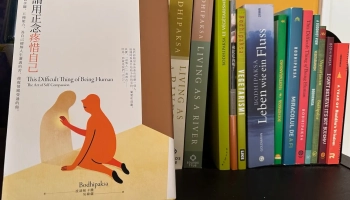
[ad_1]

The Buddha said that it was possible to dislodge unhelpful thoughts (those that make us suffer unnecessarily) with the use of more helpful thoughts. He compared this to the way a carpenter could dislodge wooden peg out of a hole by hammering a smaller peg against it.
This principle is incredibly useful in meditation, and it can be employed in a large number of ways. One popular application of this is the use of mantras, which can be chanted out loud or repeated in the mind. A mantra such as Om Mani Padme Hum, when repeated in this way, leaves less mental space for thinking. The mantra is a thought that, like a small pin applied skillfully, dislodges the larger pin of thoughts that are unhelpful because they’re expressions of worry, resentment, self-doubt, and so on.
Also see:
While you’re chanting a mantra you might not notice much happening, but afterward you feel calmer and more relaxed because you’ve given your brain and body a break from habitual patterns of thought that chip away at your sense of well-being.
Sometimes the pegs we use as tools are not traditional Sanskrit mantras, but are phrases in English. I find that these are most effective when they point us toward our experience.
A set of phrases I use a lot is “Soft Eyes, Open Field of Attention; Kind Eyes, Meeting Everything With Tenderness.” I’d like to explain why and how I use those four particular phrases.
First, the Why
“Soft Eyes”: If you know anything at all about my teaching from the last ten years or more, you’ll be aware that I almost always start a guided meditation by reminding people to soften the eyes.
“Soft eyes” means letting the muscles around the eyes be at ease, and letting the focus in the eyes be soft. You can try that right now, although you might want to look away from the screen. You’ll probably find that this is almost instantly relaxing, and that your mind becomes calmer very quickly.
Our minds are often on edge, roaming restlessly, looking for some problem that we need to pay attention to. In other words they’re controlled much of the time by the sympathetic nervous system, responsible for the so-called “fight or flight” reflex. Much of this problem-seeking involves the eyes, which stay narrowly focused and which are in constant motion.
Softening the eyes (soft focus) and letting them be still (the muscles around them being at rest) triggers the parasympathetic nervous system, which brings our system back to calm, rest, and relaxation.
With tight eyes, and the sympathetic nervous system active, we find that even in meditation the mind is still problem-solving. It’s restlessly picking through various aspects of our lives, looking for those things we’re worried about, angry about, depressed about, and so on. There’s lots of distraction.
With soft eyes, and the parasympathetic nervous system activated, the mind feels safer and loses its restlessness. It no longer needs to find problems to solve. And so it does less thinking. There’s less distraction.
So this is why I say, “Soft Eyes.” It’s a reminder for us to let the eyes be soft.
(The video above introduces the practice of “soft eyes.”)
“Open Field of Attention”: The habitual tightness we carry around in the eyes, with its narrows focus, leads to us fixating on a very narrow part of our visual field. When we close the eyes in meditation, we maintain this narrow focus in our inner field of attention.
I’ve often asked meditators to “draw” over the surface of the body what it is they’re observing when they’re doing “mindfulness of the breathing.” Because they have tight eyes and a narrow focus. most indicate a very small area, which doesn’t offer enough sensation for the mind to become fascinated by and absorbed in. And so they find they get distracted a lot.
When the eyes are soft, our inner field of attention is gentler and more open. Our attention is more expansive and receptive. We find that we’re able to sense many sensations of the breathing at once. We may even find that we can be aware of the whole body breathing. This is a very rich experience. it’s fascinating and we find it absorbing. It’s easier for us to keep observing the breathing without getting distracted all the time.
“Soft eyes” triggers an “open field of attention.” One follow naturally from the other. Nevertheless, it’s good to remind ourselves to notice what’s in our open field of attention.
Saying “Open field of attention” is a reminder to let our inner field of attention be expansive and receptive, and for us to notice the incredible richness that’s arising there.
“Kind Eyes”: Saying “kind eyes” is a way of bringing kindness into our present-moment experience. We can recall a time we looked with love — at a child, a lover, a friend, a pet — and let the eyes become kind now, as they were then. After a while we no longer need to access that kind of memory. We can simply remember what it’s like to have kind eyes, and drop back into that experience.
In saying “kind eyes” we’re directing our attention back to the eyes, reminding ourselves to connect with kindness.
“Meeting Everything With Tenderness”: Just as the eyes being soft changes our inner field of attention, causing it to be more open, expansive, and receptive, so letting the eyes become kind changes the way we pay attention internally. In this case it brings warmth, patience, kindness, compassion, and acceptance into our experience. We can find that we meet our distractions, our feelings, and even painful sensations with warmth.
Saying “meeting everything with tenderness” reminds us to bring kindness deeply into our being.
(The video above uses slightly different phrasing. More about that below.)
The How
I use the breathing to pace how quickly or slowly I drop these phrases into the mind, and to help keep my mind on track.
Pacing means balancing saying and listening.
Saying the phrases directs our attention to these various parts of our experience: softening the eyes, noticing the richness that’s arising in our open field of attention, letting kindness arise, and and bringing kindness into our whole being.
But if we’re speaking all the time, we might not be allowing ourselves to actually be with those experiences. We might not really notice them. We might not be allowing ourselves to go deeply into them.
We’re basically just talking to ourselves, and not letting ourselves have a chance to feel.
So generally I’ll say one of the phrases on an out-breath, and then leave two or three cycles of the breathing where I say nothing, and instead simply observe the experience that the phrase is pointing to.
Then I’ll drop in the next phrase, and so exactly the same thing. And I’ll continue like that through all four phrases, and then repeat.
However, if I’m particularly distractible I’ll tighten up the pacing. If I’ve been dropping in a phrase every third breath and keep getting distracted, I’ll start dropping in the phrases every two breaths. If I’m really distractible, then I might say a phrase on every breath. As I said above, this has the drawback that it doesn’t leave much time for being with our actual experience. But it’s better to do that than to get continually distracted.
Conversely, if things are going well then I might drop in the phrases less often. I might get to the point where I don’t even say the phrases; I just do what they’re describing (noticing soft eyes, noticing the body, noticing kindness in the eyes, bringing that kindness to meet every experience).
So there’s scope in this practice for fine-tuning as you go, adapting to changing conditions.
I also sometimes change the phrases. Sometimes instead of “soft eyes, open field of attention” I’ll say “soft eyes, body alive.” It’s basically the same thing, except that in the second case I’m more explicitly directing my attention toward the contents of the open field of attention. And sometimes instead of “meeting everything with tenderness” it’ll be “meeting everything with love” or “meeting everything with love.”
Although people sometimes assume that all thinking in meditation is to be avoided, thinking can be used consciously as a tool. Thoughts can direct our attention toward our immediate sensory experience. Thought can help drive out thoughts and quiet the mind.
You can play around with this tool as well. Make it your own. Find out what works for you.
[ad_2]
Source link






